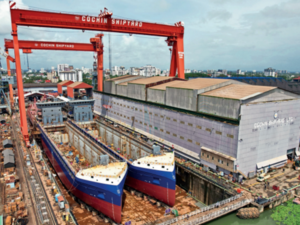
ET Year-end Special Reads
While he refrains from delving into the specifics of any potential partnership with Korean shipbuilders, he acknowledges productive engagements with industry heavyweights such as Hyundai Heavy Industries, Samsung Heavy Industries and Hanwha Ocean (formerly Daewoo Shipbuilding and Marine Engineering).
“In Kochi, we have recently added a new dry dock worth Rs 1,800 crore, but that alone won’t help much,” Nair tells ET.
The dry dock can be used for building and repairing ships. “We need a robust ecosystem of ancillary facilities to complement it. We are trying to get a major foreign partner who can bring both capital and expertise. With Chinese collaborations off the table, the choice is either a Korean or a Japanese shipbuilder,” he adds. Familiar names like Hitachi, Kawasaki and Mitsubishi are among the leading players in Japan’s shipbuilding industry.

WHEN CHINA RULES THE SEAS
As China tightens its grip on the global shipbuilding industry, New Delhi is setting its sights on a maritime makeover by courting Korean and Japanese partners to transform Indian shipyards. “China has now grown frighteningly big in shipbuilding,” says Nair, referring to a recent monthly international report that says Beijing commands a staggering 65% of the market. “China, South Korea and Japan control an overwhelming 93% of the global share,” he adds. India lags far behind, he points out. “It’s somewhere at a distant 17th position.”According to data from the Ministry of Ports, Shipping and Waterways, China holds a commanding 47% share in global shipbuilding, followed by South Korea at 29% and Japan at 17%, based on long-term averages. In stark contrast, India—despite its 5,000-year legacy of shipbuilding—owns just 1,530 vessels with a total capacity of 13.7 million gross tonnage (GT). The country accounts for a minuscule 0.07% of the global shipbuilding market and a modest 1.2% of global shipping capacity. These figures pale in comparison with the over 100,000 merchant ships—ranging from cargo and container ships to bulk carriers and oil tankers—that traverse the world’s seas.
RISING TIDE
After years of stagnation—from the collapse of Lehman Brothers in 2008 to the Covid disruptions of 2020 and 2021—the global shipbuilding industry is now experiencing a remarkable resurgence. A prolonged lull in new orders has left thousands of ageing ships in dire need of replacement, as vessels typically last just 20- 25 years before skyrocketing maintenance costs make them unsustainable.Adding fuel to this boom are tightening green regulations and ambitious net-zero targets set by developed and developing nations. Shipowners are now rushing to adopt alternative fuels like ethanol, ammonia and hydrogen, driving an unprecedented wave of demand across the industry.
Are India’s 30-odd shipyards ready to ride the wave of the global shipbuilding boom? CSL, the nation’s largest commercial shipbuilder, leads the pack with contracts to construct 65 ships, including 35 vessels for six European clients—predominantly from Germany, Norway and Britain.
Among these are two cutting-edge commissioning service operation vessels (CSOVs) for offshore wind farms, each valued at an impressive €65 million (around Rs 578 crore). However, not all players have weathered the storm.
Giants of the boom in the early 2000s, such as ABG Shipyard and Bharati Shipyard, succumbed to liquidation under the Insolvency and Bankruptcy Code. Yet, hope floats as resilient private firms such as Larsen & Toubro Shipbuilding, Goa’s Chowgule & Co and Chennai-based Tebma Shipyards are well-positioned to capitalise on the sector’s revival.
For the record, shipyards like Mazagon Dock, Garden Reach Shipbuilders and Engineers in Kolkata, Goa Shipyard and Hindustan Shipyard in Visakhapatnam—all under the Ministry of Defence—are exclusively focused on building naval vessels. Even Cochin Shipyard, despite its commercial portfolio, derives 70% of its shipbuilding revenue from defence, as reflected in its 2023- 24 figures.
“We are in touch with Korean shipyards for possible collaborations on shipbuilding projects,” says Arun Ramchandani, senior vice president & head–L&T Precision Engineering & Systems.
“Collaboration with Japanese or Korean shipbuilding majors could immensely benefit Indian shipyards in adopting global best practices, enhancing productivity and competitiveness and achieving a much higher scale of operations. With major shipyards worldwide being booked till 2028, construction of vessels under the collaboration model would also increase India’s share in global shipbuilding,” he adds.
After foraying into shipbuilding in 2006, L&T has constructed and delivered over 100 vessels, mainly for defence.
India’s policymakers and industry leaders are on the same page in the strategy to recreate the nation’s automotive triumph in the shipbuilding sector. Until the early 1980s, India’s passenger car market was dominated by Hindustan Motors’ Ambassador and Premier Automobiles’ Premier Padmini.
The landscape transformed dramatically with the arrival of Japanese biggies such as Suzuki and Toyota, alongside South Korea’s Hyundai, mainly in the 1990s. This strategic shift propelled India to its current standing as the world’s fourth largest automobile manufacturer and third largest auto market by sales — trailing only China and the United States. What’s more, India is now a big exporter of vehicles to Africa and Southeast Asia.
WHERE ARE THE SHIPS?
Replicating India’s automotive success story in shipbuilding is not quite straightforward. Unlike cars where a vast domestic market drives demand, India’s shipping industry remains in its infancy. “For shipbuilding to succeed, you need a strong shipping industry. And that’s how China’s shipbuilding grew,” says former shipping secretary Gopal Krishna. “India needs robust domestic shipping liners. That will create demand. Without it, private shipyards will struggle to stay afloat. Many private shipyards had to close down,” he says, adding that only those serving defence needs have managed to survive the tide. The government has begun to address the challenges by introducing two key bills in the last Lok Sabha session. The Merchant Shipping Bill, 2024, aims to simplify vessel ownership and other regulatory processes, while the Coastal Shipping Bill, 2024, seeks to liberalise licensing for Indian vessels operating along the coast and within the country’s exclusive economic zone (EEZ), extending up to 200 nautical miles. However, neither of these measures directly addresses the core issue of boosting shipbuilding itself.
So, in a strategic move, the government is pooling ship requirements from public sector companies across industries —from petroleum to fertilisers — to generate ready-made demand and attract partnerships from foreign shipbuilding giants.
“Our projections show India will need 50 oil tankers over the next 15 years,” says an official, speaking on condition of anonymity. “This represents a substantial, ready order for Indian shipbuilders.” Recognising the mounting costs of dollar payments for chartering foreign vessels—a figure currently nearing $80 billion annually — the government has ramped up efforts to curb the reliance on foreign ships and incentivise domestic production.
Central to this strategy is the upcoming overhaul of the Shipbuilding Financial Assistance Scheme, which has benefitted 18 Indian shipyards, according to the Economic Survey of 2023-24. This subsidy scheme for contracts signed between 2016 and 2026 may be phased out a year earlier, by March 31, 2025, if the enhanced version is approved soon and announced in the February 1 budget.
“The new scheme could maintain a flat 20% subsidy, unlike the current policy where rates decline annually,” says the official. “For green shipping, subsidies might go as high as 30%, aligning with the vision of establishing India as a hub for sustainable shipbuilding.”
The proposed revisions could also eliminate a Rs 40 crore cap, with an estimated cost to the exchequer of Rs 18,000 crore if the finance ministry approves it as proposed. The government is also contemplating a Maritime Development Fund for bolstering the shipbuilding industry.
Replying to ET’s queries in writing, Minister of Ports, Shipping and Waterways Sarbananda Sonowal says: “South Korea and Japan have shown interest in building ships in India.”
He lists companies such as Samsung Heavy Industries, Hyundai Heavy Industries, Hanwha Ocean and HD Korea Shipbuilding among those interested. “Several states such as Gujarat, Maharashtra, Andhra Pradesh and Odisha are also keen to have shipbuilding and ship-repair clusters,” he adds.
The bottom line is clear: India must overhaul its entire shipping ecosystem to build a robust and competitive shipbuilding industry.
With Indian flagged vessels carrying just 5% of the nation’s overseas cargo, the urgency is undeniable. As global turbulence makes access to foreign oil and gas resources increasingly precarious, shipbuilding transcends an economic priority—it becomes a cornerstone of India’s strategic security and resilience.
(Catch all the Business News, Breaking News, Budget 2024 Events and Latest News Updates on The Economic Times.)
Subscribe to The Economic Times Prime and read the ET ePaper online.
Read More News on
(Catch all the Business News, Breaking News, Budget 2024 Events and Latest News Updates on The Economic Times.)
Subscribe to The Economic Times Prime and read the ET ePaper online.









































 Get Unlimited Access to The Economic Times
Get Unlimited Access to The Economic Times
